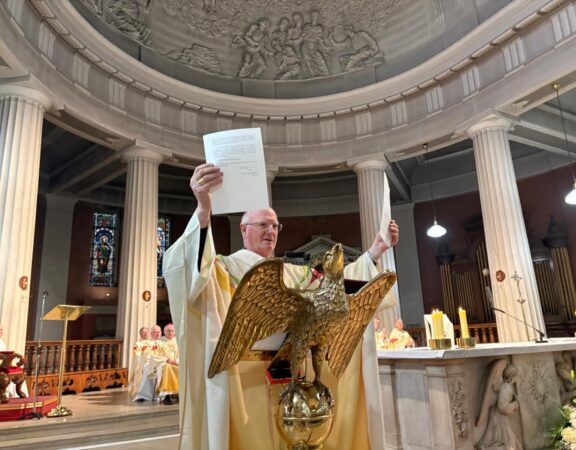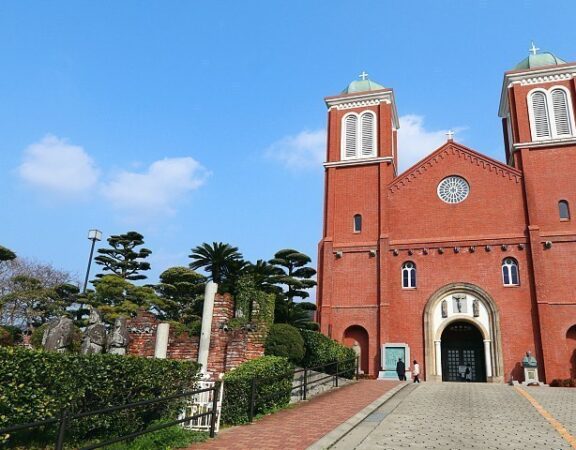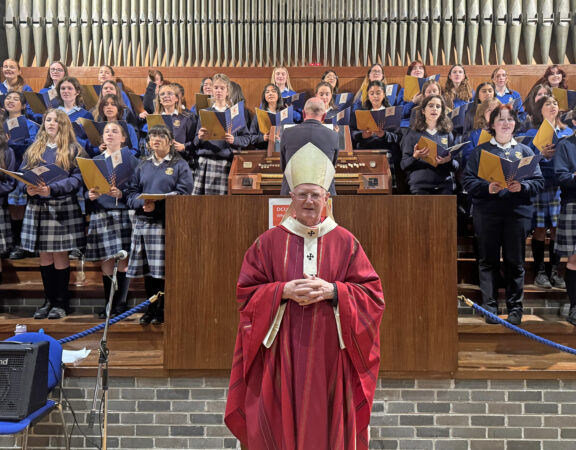MASS FOR THE REFURBISHMENT OF THE CHURCH OF THE ANNUNCIATION RATHFARNHAM
Homily notes of Most Archbishop Diarmuid Martin
Church of the Annunciation, Rathfarnham, 8th December 2013
“We gather in prayer and reflection as we give thanks to God and invoke God’s blessing on this handsomely restored Church of the Annunciation in Rathfarnham. We gather and we look back over the history of this Church and of this community. We gather in early Advent, a time when we are called to look forward in expectation to the coming of Jesus.
Perhaps in Ireland we did not have a strong tradition of popular celebration of Advent. The Advent wreath which is today very popular is an imported tradition, but one which can help us to understand the season of Advent and to find a more authentic way to prepare for Christmas.
Advent is about hope and expectation and looking forward. It is about preparing for Christmas through the way we live. Week after week, candle after candle, we move forward reviewing our lives and renewing of our lives in the expectation of the coming of Jesus.
Today that special figure of the Advent liturgy appears in our Gospel reading: John the Baptist. John the Baptist is a remarkable figure. He is the first prophet to appear among the Jewish people for centuries. His preaching and his baptism create astonishing interest right throughout society. Even secular historians mention John the Baptist’s mission. With John the Baptist, a climate of expectation emerges.
Literarily tens-of-thousands of people went out to hear John and to be baptized by him. There was something in his life-style and his integrity and uncompromising honesty which mystified people of all backgrounds.
His message was stark and uncompromising. It was a message of repentance. He had no fear of challenging those who somehow or other felt that they belonged to a political or religious establishment and could therefore live happily ensconced in their own self-created security, feeling that they had no need to change.
Let us look more closely at how the Gospel presents John. Firstly he appears in the desert. The wilderness in which he appeared was particularly barren; it had nothing of the sophisticated and comfortable and secure amenities of life. He clothes himself in the simplest of elements which were at hand, far away from the false security that we think we can win through having fashionable and designer label clothes. His food was spartan and absolutely natural. There was nothing sophisticated or incoherent or sham about his life-style. This is the figure who is presented to us a model as we prepare for Christmas.
I do not want you to think that I am a spoilsport. We have to enjoy Christmas. It is a great feast. It is a family celebration. It is a celebration of joy. It is a moment when people return home to be together and to refind the values of being with and for each other. Christmas is so special that being alone at Christmas must be one of the saddest of all experiences. There is something about the message of Christmas which consumerism can never smother as long as we do not allow that to happen.
We prepare for Christmas, then, by trying to re-establish in our own lives and in our hearts and in our communities the desire to create a world of truth, harmony and love and we do that though the integrity of our lives. I find it interesting that many of the comments we have heard at the passing of Nelson Mandela noted that his greatest gift was his integrity, that he really lived the values he spoke about.
In Saint Matthews Gospel – the one that we have just heard – then introduces a group of Pharisees and Sadducees who take exception to John’s teaching and his criticism of them. “We have Abraham for our Father” they think. We know better! We have our way and we are not changing!
Right throughout history there is the perennial temptation for us believers somehow to feel that that our understanding of faith is complete and correct. We can come to feel that we have no need to change. All of us fall into that temptation. We feel that we know what the Church should be like; we think that we know what Christ is like. It is the temptation of looking to faith as a comfort-zone rather than a challenge to open to the future with hope.
The challenge for the Church today is not just to adapt or to fit in to modern culture, much less to cling to a closed culture of the past, but to be out in society challenging what is empty and false and witnessing coherently to the values that endure.
Coming here this afternoon I had been told that the refurbishment of the Church was quite stunning. But strangely I kept thinking about the history of the Church. This refurbishment has turned out so well because the original Church building, opened in 1878, was an exceptional building. I thought especially of the people, who in that very different world, inspired and indeed contributed to building this outstanding building. Rathfarnham was then just a small village on the outskirts of Dublin. Those people were truly Advent people: people who looked towards the future, strengthened in their faith at a time of difficulty and uncertainty in Irish history. They were forward looking people who set out to build the best, rather than compromise with the mediocre. That is what Advent people are.
As always when I get involved in history and dates – do not let the professional historians hear this – I go to Google. I saw that in 1878 Cardinal Cullen died and was succeeded by Archbishop McCabe, who blessed this Church. Otherwise, I am afraid that I got very little that would strike a chord with us today, except that the first-ever floodlit football game took place in 1878 and also that three well-known football clubs were established in England: Everton Football Club, Ipswich Town Football Club and “Newton Heath Lancashire and Yorkshire Railway Football Club”, which as you all know later became known as Manchester United.
1878 was a different world, but the people of this area were forward looking people. That is a lesson for us today. The Church in Dublin and in Ireland has faced many challenges and indeed still does. But our ceremony here today is a sign that the community of believers has not lost its way. This refurbishment and indeed this ceremony are both signs of a forward-looking and more confident Church.
The refurbishment of the building is a sign of the renewal that is taking place in the life of the Church. This ceremony is a sign of how quietly we are renewing the best of our past, and thus giving signs of hope for the future.
This Church building has been the focal point of transmitting and renewing the faith over generations and that transmission of the faith has contributed to the building up of those values of love and solidarity which spring from our faith and which our faith must continue to bring to Irish society of the future.
This building is a sign of how the beauty of the message of Jesus can be made new in each generation. We need a forward-looking Church. We do not need a Church of people who think like those Sadducees, that because they have Abraham for their Father they have no need for renewal.
Pope Francis has called for a Church whose doors are open and welcoming. This Church stands at a crossroads in this community and has done so since 1978: a landmark, a sign of welcome, a focal point for the paths of the lives of the people of this community, a source of inspiration and consolation, a place of invitation to prayer and communion with God.
We give thanks to God for this refurbishment and for the work of all who contributed to this project. May this refurbished Church be an invitation to all who pass-by in the years to come to seek that authenticity and fulfilment in their lives and for their future which alone can be found in the message of Jesus, the one whom we await in hope in this season of Advent.” ENDS
|







